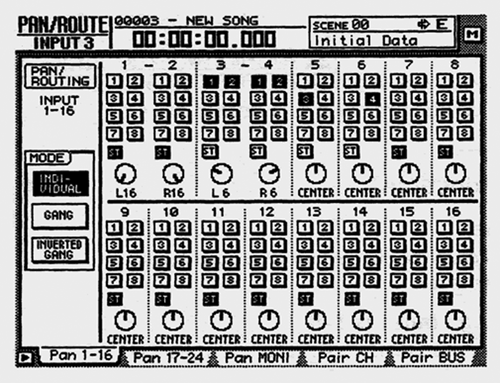THE FRONT PANEL
A glance at the front panel reveals the AW4416’s heritage. If you’re familiar with Yamaha’s digital mixers, particularly the 02R, you should feel right at home.
The AW4416 presents a lot of information in a small space. Measuring approximately 3-1/2 by 4-1/2 inches, the main backlit LCD display handles everything from track info to information about routing. Each screen provides several pages of information, and there are three ways of accessing the different pages: pressing a selection button repeatedly, pressing function keys immediately below the main display, or using the optional mouse. A second display is dedicated to showing levels for the recorder tracks and main outputs, counter location, clock source, and other useful details.
The unit has more than a hundred buttons and knobs, including four knobs dedicated to hands-on control of pan and parametric EQ. Some buttons control seemingly unrelated functions; for example, the EQ button also accesses pages for fader and mute groups. Likewise, the Dynamics screens contain pages for channel polarity and track offset. It may take a while to get used to this sort of multilevel functionality.
The 60 mm motorized faders serve a variety of functions, operating inputs 1 to 24, aux sends or returns, and returns from the recorder. Change a scene or mode, and the faders instantly jump into position, eliminating any doubt about their settings. And let’s face it, moving faders (even short ones) are great fun to watch. Finally, these are noticeably quieter than faders on other Yamaha digital boards — they don’t exhibit the clatter of the older ones.

PATCH ‘EM HERE AND THERE
Flexible signal routing is the AW4416’s key strength. Mixer input choices include those you’d expect — analog inputs, S/PDIF in, the sampling pads, and any option slot inputs.
The multiplicity of output routing options conjures up some interesting scenarios. You can use the option slots to transfer all 16 tracks to a pair of ADATs, which lets you archive your tracks to inexpensive S-VHS tape and to send them to another studio, for example. You can route an aux send through S/PDIF to and from an outboard effects processor and use the main outputs as an extra headphone mix.
Up to 20 routing maps can be stored for instant recall. This is handy if you’re faced with numerous patching situations in your daily routine. Unlike user patches for scenes, EQ, dynamics, and effects, which are saved as song data, the routing libraries are always available.

RECORDING
Thanks to the default busing assignments, basic recording tasks are relatively painless. The defaults may be all you will ever need, but almost any kind of busing and routing option is easy to set up and store for later recall.
The transport section features friendly tape-style controls. A matrix of buttons manages loops, auto punch, and up to 99 locate points per song. Auto punch is easy to use: I was able to set punch-in and punch-out points, then roll back and fix a mistake in less time than it took to write this sentence.
The AW4416’s Quick Record mode makes recording trouble free: pressing one button arms all 16 tracks and routes the inputs directly to the recorder, with a choice of inputs from the analog jacks or the option slots. This gave me a very fast method of getting VO tracks and music beds recorded.
Each of the 16 physical tracks has up to 8 associated virtual tracks, and there is a separate stereo track for the finished mix. As with other virtual track schemes, the theory here is that you’ll do multiple (or alternate) takes of a given part and choose the best one for playback. With some effort, you can comp together sections of different virtual tracks into one “keeper” track. Of course, only one virtual track may be played at a time for each physical track.
Up to 30,000 songs (or what most of us know as Projects) can be stored on the internal drive. A song is stored as a proprietary form of .WAV file in the AW4416, but recent software updates now let you export from a track to a standard .WAV file. The 12 GB disk that came with my unit afforded about 140 minutes of 44.1 kHz recording time at 16 bits. And while the external SCSI jack on the back of the recorder shows promise for expanding recording time, it can currently be used only for backing up and restoring song data, while the CD-RW drive can be used for mastering audio CDs, backing up/restoring songs or importing CD tracks and WAV files.
On the software side, the AW4416 offers an impressive list of capabilities. Most notable is the system’s automation recorder — a direct descendant of the software found in the 02R mixer. It allows easy automation and editing of fader positions, pan, EQ and aux send settings. It also recalls any of the AW4416’s 96 scene memories (per song), as well as effects, dynamics and other setting libraries. Automation data is saved with each song, there’s virtually no chance of maxing out the AW4416’s automation memory.
The 16 sample pad buttons can be assigned to play digital audio clips (up to 90 seconds total). A simple sequencer keeps track of when pads are pressed down and released. Pad outputs show up at the AW4416’s digital patchbay, and can be routed to any mixer or recorder channel.
Other features of the AW4416 include tempo and meter maps, a fully routable metronome, 99 markers per song, good locate functions, multilevel undo, fader and mute groups, automatic crossfade between regions, and user-controlled dither and bit-depth settings.

